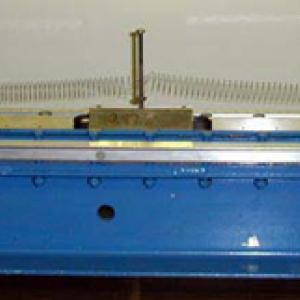College of Liberal Arts & Sciences
3A20.35 - Air Cart Masses and Springs - Air Track & 2 Springs
Attach the Plexiglas bar across the air track at the midpoint. When using the spark generator be sure that there is nothing to cause a short circuit. Attach the sparking pins to the desired car. Set the car into the track, position a length of tape under the sparking pin and tape to the railing with masking tape. Practice will be necessary. Timing gates and counters may be used if desired.
- Sándor Egri and Lóránt Szabó, "Analyzing Oscillations of a Rolling Cart Using Smartphones and Tablets", TPT, Vol. 53, #3, Mar. 2015, p. 162.
- Christopher A. Brueningsen, "Investigating Magnetic Oscillations", TPT, Vol. 31, #3, Mar. 1993, p. 184.
- Alan Cromer, "The x3 Oscillator", TPT, Vol. 30, #4, Apr. 1992, p. 249.
- John L. Kroening, "Question About x3 Oscillator", TPT, Vol. 30, #6, Sept. 1992, p. 326.
- Alan Cromer, "Response to Kroening", TPT, Vol. 30, #6, Sept. 1992, p. 326.
- George Matous and John Matolyak, "Teaching Important Procedures with Simple Experiments", TPT, Vol. 29, #8, Nov. 1991, p. 541.
- Thomas B. Greenslade, Jr., "Damped Simple Harmonic Motion on a Linear Air Track", TPT, Vol. 7, #7, Oct. 1969, p. 395.
- David Kutliroff, "69, Simple Harmonic Motion Is Displayed and Analyzed with a Cart, Springs and an Accelerometer", 101 Classroom Demonstrations and Experiment For Teaching Physics, p. 152.
- Sa-13: Freier and Anderson, A Demonstration Handbook for Physics.
Disclaimer: These demonstrations are provided only for illustrative use by persons affiliated with The University of Iowa and only under the direction of a trained instructor or physicist. The University of Iowa is not responsible for demonstrations performed by those using their own equipment or who choose to use this reference material for their own purpose. The demonstrations included here are within the public domain and can be found in materials contained in libraries, bookstores, and through electronic sources. Performing all or any portion of any of these demonstrations, with or without revisions not depicted here entails inherent risks. These risks include, without limitation, bodily injury (and possibly death), including risks to health that may be temporary or permanent and that may exacerbate a pre-existing medical condition; and property loss or damage. Anyone performing any part of these demonstrations, even with revisions, knowingly and voluntarily assumes all risks associated with them.

